The practice of adopting animal mascots in the armed forces has a long history. Many AIF battalions in World War I brought all sorts of animals along with them, including dogs, kangaroos, koalas and even a Tasmanian devil. These animals offered companionship for the troops, were a way of expressing national pride, raised morale, and offered soldiers some relief from the harsh realities of war.
There are many ways that the animals were sourced, including advertising in the newspaper. An ad in the Ballarat Courier in March 1916 reads, 'Nearly all of the brigades and battalions which have left our shores for the front have had a mascot of one kind or another... The 39th Battalion, which will bear the name of our city, Ballarat, is not yet possessed of a mascot. A gift of a well-bred fox terrier or bull pup would be much appreciated.' (The Ballarat Courier 1916) There are also examples of call outs for wallabies or kangaroos to be sent to training camps as mascots, and others were provided to battalions as gifts.
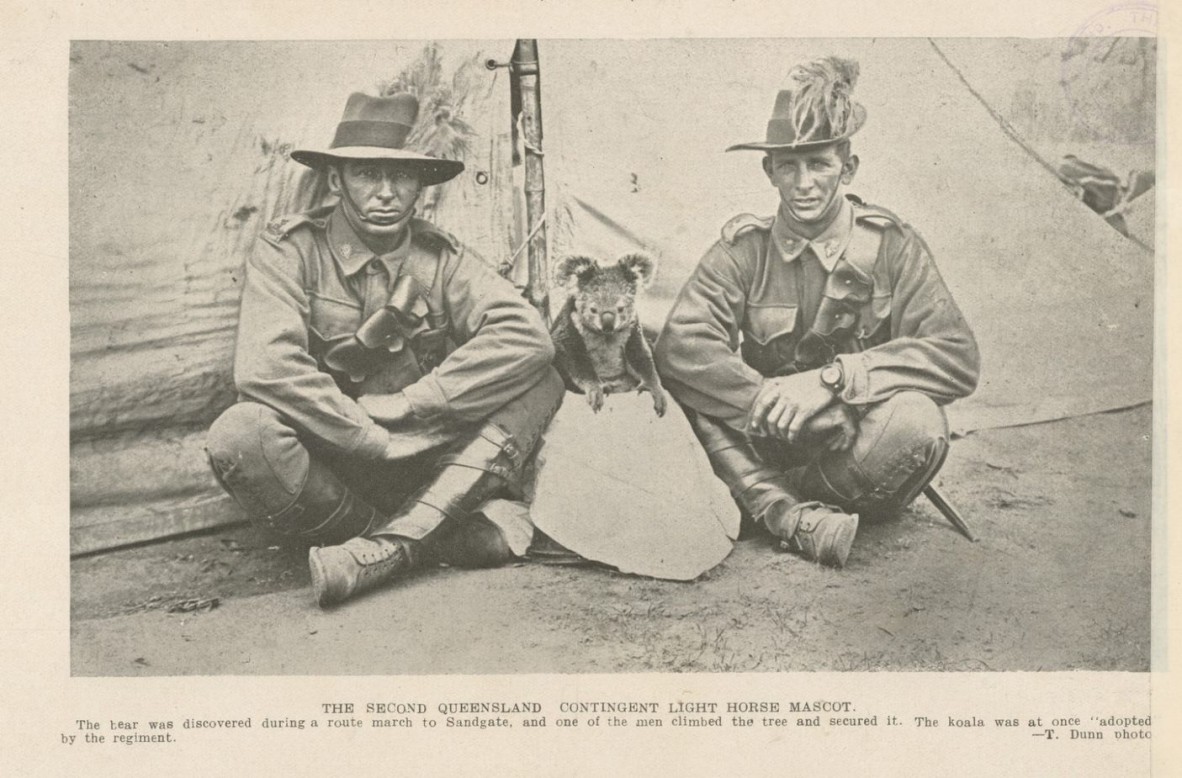
Page 23 of the Queenslander Pictorial supplement to The Queenslander 19 December 1914. Queenslander (Brisbane, Qld. : 1866-1939) ; John Oxley Library, State Library of Queensland ; 19 December 1914
Some accounts of the acquisition of mascots indicate a rather ad-hoc approach. The Queenslander in December 1914 features the newly adopted koala mascot of the Second Queensland Contingent Light Horse, and the caption reads, 'The bear was discovered during a route march to Sandgate, and one of the men climbed the tree and secured it. The koala was at once adopted by the regiment.’ (State Library of Queensland)
Australian soldiers brought animals along with them as they departed for Egypt, but an example of a battalion mascot that became lost even prior to embarkation is this 2½ year old brindle bulldog named Colonel Stone, who was the regimental mascot for the 42nd Battalion. A newspaper notice in The Brisbane Courier on 13 April 1916 states that the dog is lost and that a reward will be offered for his return to Thompson's Paddock, but it’s not clear if he was ever found.
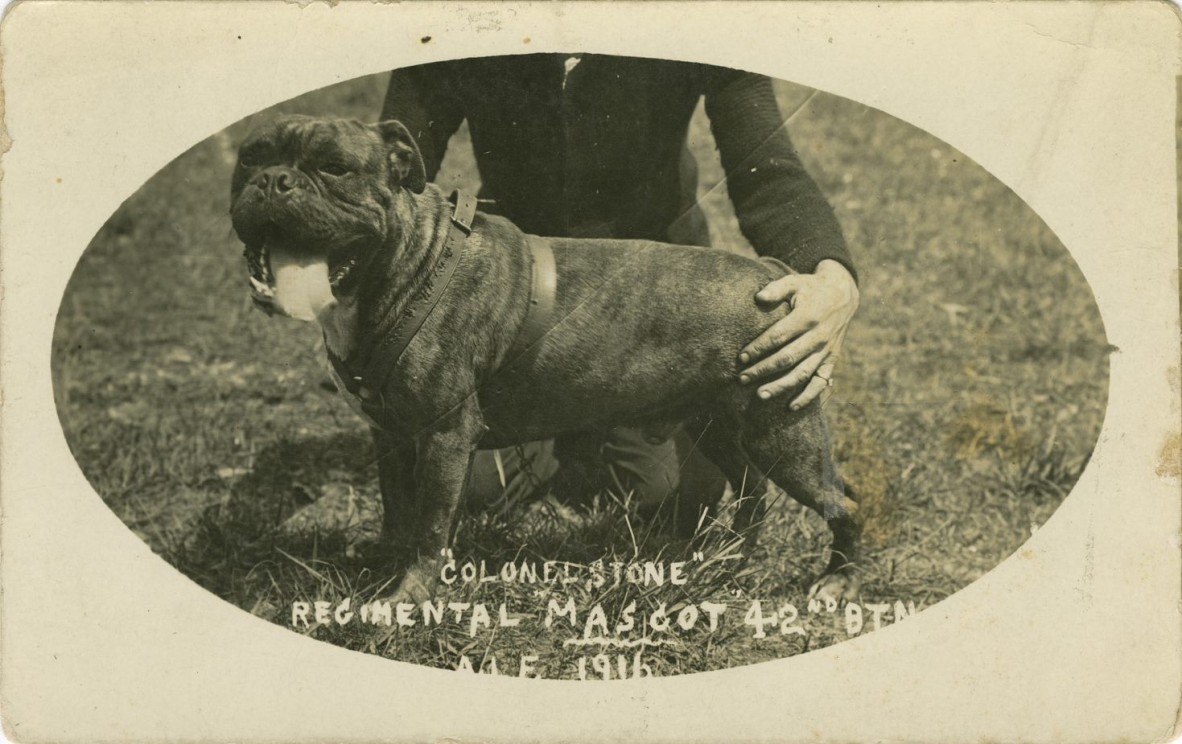
Colonel Stone the Regimental Mascot of the 42nd Battalion at the Enoggera Military Training Camp, Brisbane, 1916 (2016): 30729, McCowan Family Photographs and Correspondence. Web.
Not only was it popular to have iconic Australian animals such as koalas as mascots, but there are many photos of soldiers who seemed happy enough to pose with them. Here is another image from the Queenslander, with the caption, ‘A group of Longreach natives off to the front.’ (State Library of Queensland)
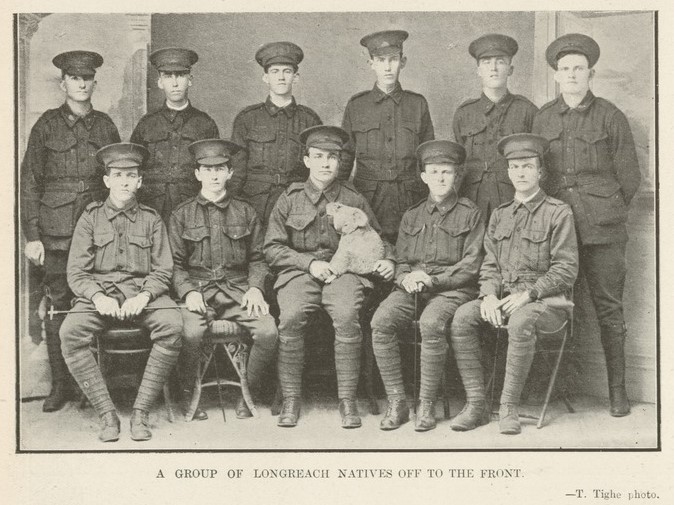
Page 26 of the Queenslander Pictorial, supplement to The Queenslander, 20 October, 1917. Queenslander (Brisbane, Qld. : 1866-1939) ; John Oxley Library, State Library of Queensland ; 20 October 1917
However, while mascots were often lavished with attention, the long-term welfare of the animal was not necessarily given due consideration. Arthur Wallace Stewart, who served at Gallipoli with the 26th Battalion, recounted a story of just one of the many animals that were left behind as soldiers departed for the front.
"When some of the Tasmanians were in camp at Enoggera, one of them brought a koala in as the battalion mascot. It was brought by boat to Sydney, stayed there for a week, and then went on with the troops to Egypt. It was in camp there for a couple of weeks, during which time hundreds of English soldiers came from every camp nearby to admire it. The battalion was soon to go into action, so the koala was sent to the Egyptian Zoo. I believe it died a few weeks later. The 'Digger' who was in charge of it while it was with the battalion was an ex-circus owner, and during the time he had it the bear was always bright and healthy. On the voyage it was allowed to roam the boat. Its food consisted of gum leaves, pears, and other fruit, the gumleaf supply lasting only for a fortnight of the ship's voyage." (Examiner 1937)
Lance-Sergeant J. W. Kerr, a soldier with the First Expeditionary Force in Egypt, made this eloquent observation of Australian soldiers in a letter dated January 31, 1915, which was subsequently published in the newspaper. This perhaps sums up why so many soldiers brought uniquely Australian animals along with them.
“One would not class the average, devil-may-care, venturesome Australian soldier as a sentimentalist, but if you saw him in the Zoological Gardens in Cairo you would speedily come to the conclusion that he was. Although there are many weird, unshapely, tropical animals he prefers to stand and gaze in happy approbation at the silly antics of a youthful kangaroo, and is moved to ecstatic and thoughtful delight when he hears the shrill call of the magpie, the chattering of a parrot or cockatoo, or the gee-haw of a kookaburra, and no wonder. You seem to be living amid all these wonderful relics of antiquity, in some long gone-by age, and the musical notes of our native birds recall home and friends and kindred ties in a manner that is hard to describe. You forget the little part you are playing in the Empire's history and the world's affairs, your bayonet is for the moment sheathed and your rifle is for the moment laid by; across the longest gleam of golden sunshine you see, thousands of miles away, the domicile, which, ever so humble, is home." (Cobden Times and Heytesbury Advertiser 1915)
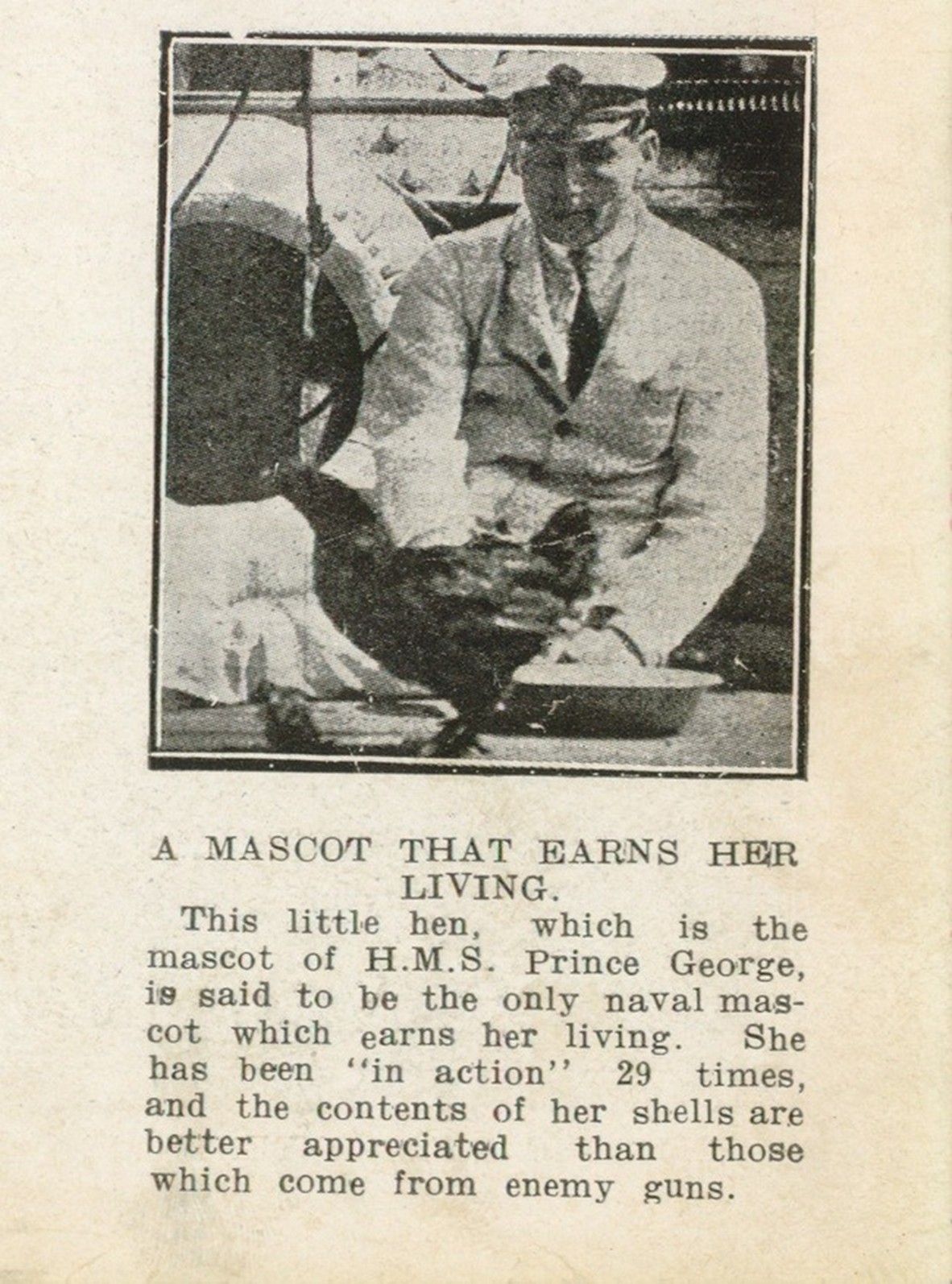
Page 27 of the Queenslander Pictorial, supplement to The Queenslander, 12 February, 1916.
It’s important to note the distinction between mascots and service animals, which are trained to perform tasks and serve in combat roles. However, that’s not to say that mascots couldn’t earn their keep. This chicken mascot of the H.M.S. Prince George was reportedly in action 29 times, and to quote the article, ‘the contents of her shells are better appreciated than those which come from enemy guns.’ (State Library of Queensland)
By World War II there appears to be an increasing trend to not take the animals overseas at all, and numerous mascots did their bit by staying at home and raising funds for the battalion instead. One example was a rabbit named Rudolph, the mascot for the 2/9th Battalion. Described as a ‘white Angora rabbit who drinks beer and eats anything’ (Northern Star 1940), Rudolph was given his own battalion number and officially entered the ranks with a ceremony held in a private arms, complete with a band playing ‘Retreat’ and a toast by the officers present. Rudolph was also treated to a rather extravagant gift, being issued his own uniform of red velvet at a cost of £2, with ‘2/9th Battalion, Second AIF’ printed in gold lettering. He also possessed his own beer mug.
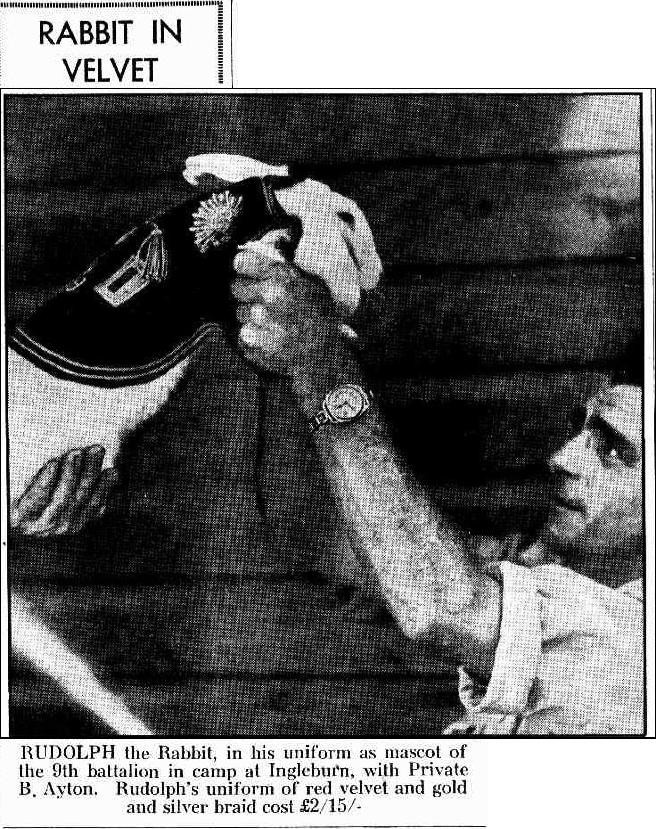
The 2/9th Battalion was known for its service in Tobruk, Milne Bay, Sanananda, Shaggy Ridge and Balikpapan in World War II, but Rudolph was destined never to join his comrades overseas as he instead stayed in Brisbane, cared for by the mother of one of the battalion members. He was tasked with appearing in photographs that were sold to raise battalion funds, with the battalion band playing to wish him farewell. Not content with just beer, Rudolph reportedly started to take a liking to whiskey as well, but it was noted that this was being discouraged ‘on economic grounds’ (Northern Star 1940).
A warzone is a dangerous place for humans and animals alike, and in World War I many animals were injured or died in transit and in combat zones, or met with quarantine restrictions upon returning to Australia. While early adoption of mascots was ad-hoc and without sufficient concern for the animal’s long-term welfare, mascots in the Australian Army in recent years have focused more on structured integration with the functions of the regiment. Mascots can be chosen for symbolic reasons or based on tradition, with due consideration given to how they can be trained and serve as full members of the regiment, their promotion (or demotion) in the ranks and even their subsequent retirement from duties.
Cairns, Hamish, 8th/9th Battalion, Royal Australian regiment, marching with their mascot, a Merino ram called John MacArthur in the Brisbane Anzac Day Parade, 25 April, 2015, pp.29874 Hamish Cairns Anzac Day Photographs 2015.
A recent example of a battalion mascot is the merino sheep mascot of 8th/9th Battalion. Bearing the name of that very colourful character in the Merino sheep industry, Corporal John Macarthur VII aka ‘Stan the Ram’ was born in 2015 and subsequently enlisted in the 8th/9th Battalion, Royal Australian Regiment. The Battalion’s mascots are chosen because they are brave, aggressive, steadfast and resolute in the face of danger, which are desired qualities in the soldiers of the Battalion.
Animal mascots featured as part of our free talk series that explores Queensland's diverse and unique military history and draws on the State Library of Queensland’s military collections. To view all of our upcoming talks, visit the What’s On page on our website.
https://www.anzacsquare.qld.gov.au/whats-on
References
1915 'CAMP CHRONICLES.', The Bendigo Independent (Vic. : 1891 - 1918), 8 October, p. 6. , viewed 17 Oct 2022, http://nla.gov.au/nla.news-article220897158
1915 'LETTER FROM EGYPT.', Cobden Times and Heytesbury Advertiser (Vic. : 1914 - 1918), 27 March, p. 2. , viewed 03 Aug 2022, http://nla.gov.au/nla.news-article122877837
1915 'MASCOT.', The Muswellbrook Chronicle (NSW : 1898 - 1955), 8 May, p. 2. , viewed 17 Oct 2022, http://nla.gov.au/nla.news-article107833478
1916 'A BATTALION MASCOT.', The Ballarat Courier (Vic. : 1869 - 1885; 1914 - 1918), 13 March, p. 4. (DAILY.), viewed 30 Sep 2022, http://nla.gov.au/nla.news-article74504029
1936 'A.I.F. Mascots.', Western Mail (Perth, WA : 1885 - 1954), 5 November, p. 2. , viewed 05 Aug 2022, http://nla.gov.au/nla.news-article50059256
1937 'CURRENT TOPICS', Examiner (Launceston, Tas. : 1900 - 1954), 16 July, p. 8. (LATE NEWS EDITION and DAILY), viewed 30 Sep 2022, http://nla.gov.au/nla.news-article52149788
1939 'A.I.F. CONCERT TOMORROW NIGHT', The Advertiser (Adelaide, SA : 1931 - 1954), 13 December, p. 24. , viewed 17 Oct 2022, http://nla.gov.au/nla.news-article35654436
1940 ''Ale! Rudolph', The North Western Courier (Narrabri, NSW : 1913 - 1955), 6 May, p. 2. , viewed 17 Oct 2022, http://nla.gov.au/nla.news-article135222093
1940 'Beer-Drinking Rabbit Mascot', Northern Star (Lismore, NSW : 1876 - 1954), 20 February, p. 1. , viewed 24 May 2022, http://nla.gov.au/nla.news-article95496135
1940 'RABBIT IN VELVET', The Daily Telegraph (Sydney, NSW : 1931 - 1954), 23 February, p. 1. , viewed 30 Sep 2022, http://nla.gov.au/nla.news-article248228243
Australian Army 2018, 17 January 2018, viewed 30 September 2022, https://www.facebook.com/AustralianArmy/posts/didyouknow-that-a-number-of-australian-army-units-have-mascots-the-8th9th-battal/10155724420191195/
Australian War Memorial n.d., '2/9th Australian Infantry Battalion', viewed 17 October 2022, https://www.awm.gov.au/collection/U56052
Cairns, Hamish, 8th/9th Battalion, Royal Australian regiment, marching with their mascot, a Merino ram called John MacArthur in the Brisbane Anzac Day Parade, 25 April, 2015, pp.29874 Hamish Cairns Anzac Day Photographs 2015, http://onesearch.slq.qld.gov.au/permalink/f/1oppkg1/slq_digitool991496
Colonel Stone the Regimental Mascot of the 42nd Battalion at the Enoggera Military Training Camp, Brisbane, 1916 (2016): 30729, McCowan Family Photographs and Correspondence. Web, http://onesearch.slq.qld.gov.au/permalink/f/1oppkg1/slq_alma21301411470002061
National Army Museum n.d., 'Billy', regimental goat of the 2nd Battalion Royal Welsh Fusiliers, 1955 (c), viewed 17 October 2022, https://collection.nam.ac.uk/detail.php?acc=1960-05-295-1
Page 23 of the Queenslander Pictorial supplement to The Queenslander 19 December 1914. Queenslander (Brisbane, Qld. : 1866-1939) ; John Oxley Library, State Library of Queensland ; 19 December 1914, http://onesearch.slq.qld.gov.au/permalink/f/1oppkg1/slq_digitool775884
Page 26 of the Queenslander Pictorial, supplement to The Queenslander, 20 October, 1917. Queenslander (Brisbane, Qld. : 1866-1939) ; John Oxley Library, State Library of Queensland ; 20 October 1917, http://onesearch.slq.qld.gov.au/permalink/f/1oppkg1/slq_alma21281444040002061
Page 27 of the Queenslander Pictorial, supplement to The Queenslander, 12 February, 1916, http://onesearch.slq.qld.gov.au/permalink/f/1oppkg1/slq_alma21281421430002061
Comments
Your email address will not be published.
We welcome relevant, respectful comments.